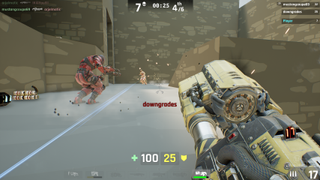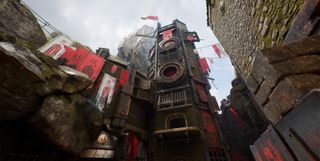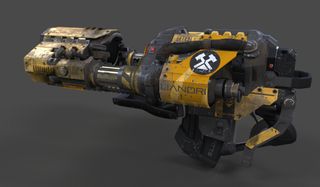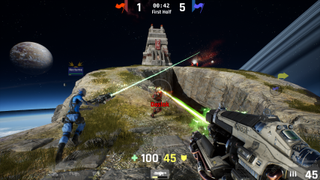It's time to pay attention to the new Unreal Tournament
Epic talks about the state of Unreal Tournament, two years in: frenetic, fun, and still very unfinished.

Playing Epic’s new Unreal Tournament sometimes makes me think of those meta moments in cartoons where characters break out of their animated reality and are suddenly standing in an expanse of white nothingness. Here I am firing off flak shots from a beautifully rendered gun, dodging and sliding and tracking my enemies by the sounds of their footsteps—all in a greybox map, the bleached geometric bones of what could eventually look like ancient ruins or a lunar outpost. The shape of a map is there, but none of the textures that bring it to life.
Twenty eight months in, Unreal Tournament is the most openly unfinished game I’ve ever played. Epic announced its plans to revive the series and develop it openly with the community in May 2014, and for the past two years it’s been quietly doing just that. The team added weapons and worked on movement early on, giving players a chance to jump around in naked, unfinished maps. There are modes and features missing, regular tweaks to just about everything that makes a game tick.
Surprisingly, for a game that's so unfinished, Unreal Tournament is also immediately fun. It’s fast and relentless in that classic deathmatch way, with new dodges added to UT’s classic dance repertoire. This strikes me as a rare dichotomy in the days of polished alphas and marketing betas, and if you’ve ever wanted to know more about how games are made, here’s a good chance: Epic is building one right before your eyes.
“It’s almost like we’ve been using the actual software terms [for alpha and pre-alpha] as opposed to the marketing messaging people have,” jokes producer Zack Estep, chatting from Epic’s North Carolina office.
If you’ve ever wanted to know more about how games are made, here’s a good chance: Epic is building one right before your eyes.
“Now we’re getting pretty close to where we feel like we’ll be at alpha,” adds Steve Polge, the project lead on UT and a programmer on the series since, well, the very beginning, with 1998’s Unreal. He’s been called the Master of the Unreal Universe, Estep notes.
Polge and Estep are two members of a small team working on Unreal: about a dozen developers and another eight or so QA testers. Polge explains that even after two years they’re still a pre-production team, whose work on the game involves “answering all the questions we have to solve so we can go into full production. Once we have our path set, hopefully we can scale up and get the game done in a reasonable amount of time.”
The team spent the first year of work recreating a modernized version of the classic UT. That meant adding in most of the series staple weapons and game modes like deathmatch, CTF, and Instagib. Level designers have been dividing their time between recreating old maps like Facing Worlds and building new ones. Throughout this process, the community has been pitching in. Community manager Stacey Conley says that Epic talks to fans everywhere it can, including the Unreal forums, Twitter, and a dedicated Discord channel. Those fans have had a hand in almost everything, from the minutia of balance tweaks to actually building maps and weapons.
The biggest gaming news, reviews and hardware deals
Keep up to date with the most important stories and the best deals, as picked by the PC Gamer team.

Design by community
There’s probably no more hotly debated element of Unreal Tournament than movement. Should it be fast or really fast? Forum comments call out the game for being too slow, though Epic says the community has overall been happy with the way the game plays. They helped dial it in, after all.
“There were many community members making their own movement prototypes,” Polge says. “One guy came up with lots of wall running ideas. We didn’t incorporate everything he did, but it certainly informed a lot of our decision making. There were guys drilling down to parts of the acceleration curve and things like that. We had a lot of community feedback, and it had a big impact.”
That impact is easy to see in the maps already in the game. The official build already contains a pair of community deathmatch maps alongside finished maps and shells designed by Epic. Polge says they expect to have more finished maps from the community than from Epic integrated into the official build within the next few months. Even more will be available on the marketplace, where members can give away or sell their creations.
One of the most significant contributions from the community so far is the Flak Cannon, aka the best gun in PC gaming. It was modeled by modder Paul Stratton, who told me he started building it as a personal art piece. “I showed the basic work-in-progress screenshots to the UT development community and they really responded well to it,” he writes over email. “Never in my wildest dreams did I think my artwork was of the quality level Epic was looking for, so when they dropped the news that they were interested in using it for the game, I had to do a double-take. Overall, the opportunity that is being offered by Epic is invaluable to hobbyist and amateur artists who want to take the next step in their career."

Stratton has been building things in Unreal Engine since he was 13 years old in the early 2000s, when he found out the original Unreal Tournament shipped with the editor on-disc. It’s a common story in the games industry—there are members of the new Unreal development team that Epic hired from the community, even.
Like Stratton, modder (and community moderator) Chris Morris sees the open development of UT as a huge opportunity “to see what development looks like more closely [and] to get maps tested in a way I never would have before,” he wrote over email. But he also recognizes some challenges in listening to the community. In recent months, every new build has been met with a rash of complaints.
“Obviously this is the internet,” he wrote. “There will always be small groups that will go out of their way to express their strong opinions, especially about things they’re passionate about. However the amount of vitriol thrown at the developers is awful and only serves to damage the open nature of the project. The amount the devs were communicating took a hit earlier in the year and I partly blame it on this negative attitude.”
But he thinks things have been getting better. Morris pointed to the more casual (and less permanent) setting of the Discord channel as a great place for feedback, where the devs often come to chat about changes.
Stratton is now working on a model of the Bio Rifle, which is already in the game—like most of Unreal Tournament’s current pieces, the existing model is a pre-alpha placeholder that needs to change for the final game.
The Sniper Rifle in the official build also came from the community, and producer Zack Estep says there’s a version of the Ripper, UT99’s spinning sawblade gun, out in community maps. It hasn’t been incorporated in the official build, which brings up another unusual aspect of Unreal Tournament’s communal development: there are mods and forked builds of the game, even though it’s still in pre-alpha.

One of the biggest mods Polge called out is Absolute Elimination, based on the Team Arena Master mod for UT2K4. Pickups are removed from the map, each player has only one life per round, and starts with a full complement of weapons.
“Right now it’s a community thing,” Polge says. “We don’t want to bring it in as an official part of the game because that limits their ability to continue iterating on it and making it better, but we certainly support that kind of thing. If lots of UT players are playing that mode, it’s part of UT, even if it didn’t come from us.”
When I asked Polge if it was more stressful to develop a game with so many voices giving input, he countered that it was more stressful to work on a game for a long time without releasing it, knowing that no matter how big your QA staff is, thousands of players will always find bugs and exploits they couldn’t catch. But his biggest challenge, as the project lead, is deciding just what kind of Unreal Tournament this should be.
“You have a lot of people that are very passionate about Unreal Tournament, and their vision of what Unreal Tournament should be, and they’re very angry if you’re not fulfilling what their vision is,” he says. “And that’s not stressful in itself. What’s stressful is that you have these different points of view that are all really appealing, and you want to address them, but it’s hard to do all that. How do we build something that has the right set of compromises that fits the vision of where UT should go, and all these visions of what people think UT should be?”

Wes has been covering games and hardware for more than 10 years, first at tech sites like The Wirecutter and Tested before joining the PC Gamer team in 2014. Wes plays a little bit of everything, but he'll always jump at the chance to cover emulation and Japanese games.
When he's not obsessively optimizing and re-optimizing a tangle of conveyor belts in Satisfactory (it's really becoming a problem), he's probably playing a 20-year-old Final Fantasy or some opaque ASCII roguelike. With a focus on writing and editing features, he seeks out personal stories and in-depth histories from the corners of PC gaming and its niche communities. 50% pizza by volume (deep dish, to be specific).
Most Popular


